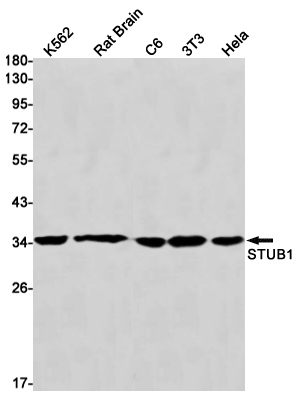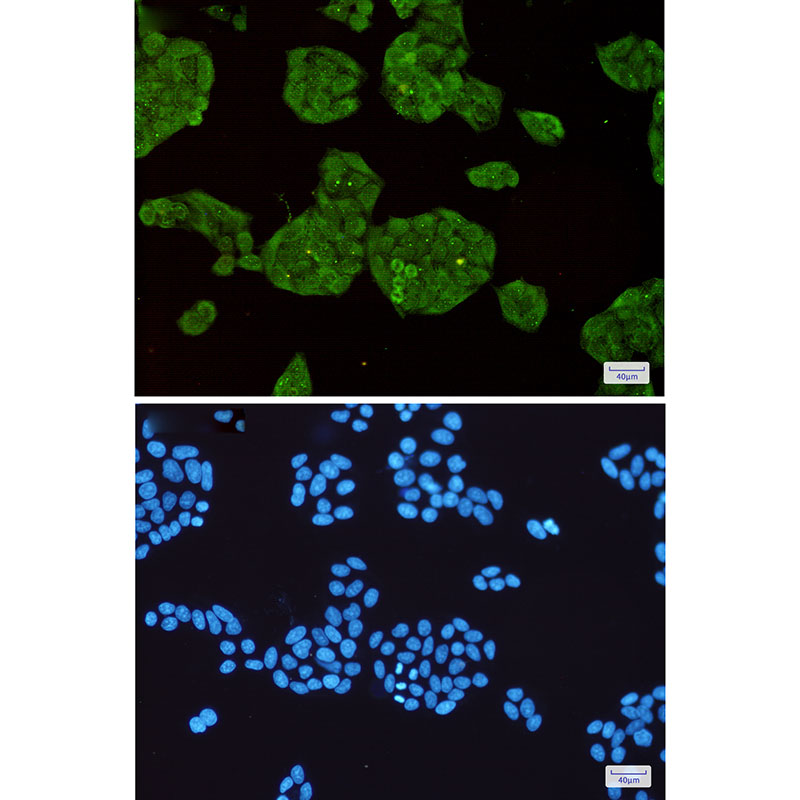

| WB | 1/500-1/1000 | Human,Mouse,Rat |
| IF | 1/20 | Human,Mouse,Rat |
| IHC | 咨询技术 | Human,Mouse,Rat |
| ICC | 1/50-1/200 | Human,Mouse,Rat |
| FCM | 咨询技术 | Human,Mouse,Rat |
| Elisa | 咨询技术 | Human,Mouse,Rat |
| Aliases | STUB1; CHIP; HSPABP2; NY-CO-7; SDCCAG7; UBOX1 |
| Entrez GeneID | 10273 |
| WB Predicted band size | Calculated MW: 35 kDa; Observed MW: 35 kDa |
| Host/Isotype | Rabbit IgG |
| Antibody Type | Primary antibody |
| Storage | Store at 4°C short term. Aliquot and store at -20°C long term. Avoid freeze/thaw cycles. |
| Species Reactivity | Human,Mouse,Rat |
| Immunogen | A synthetic peptide of human STUB1 |
| Formulation | Purified antibody in TBS with 0.05% sodium azide,0.05%BSA and 50% glycerol. |
+ +
以下是关于STUB1(CHIP)抗体的3篇代表性文献,简要整理如下:
1. **文献名称**:*CHIP functions as a novel component of the mammalian clock system*
**作者**:Dai et al. (2005)
**摘要**:研究揭示了STUB1(CHIP)作为E3泛素连接酶在调控哺乳动物生物钟中的作用,通过泛素化降解核心时钟蛋白PER1/2维持节律稳定性。实验中利用STUB1抗体验证其与PER蛋白的相互作用。
2. **文献名称**:*STUB1 mutations in autosomal recessive forms of cerebellar ataxia*
**作者**:Shi et al. (2014)
**摘要**:报道了STUB1基因突变与隐性遗传脊髓小脑共济失调的关联,通过免疫印迹(Western blot)结合STUB1抗体发现突变导致蛋白稳定性下降,提示其功能缺失引发神经退行性病变。
3. **文献名称**:*CHIP modulates parkin-mediated mitochondrial quality control*
**作者**:Madorsky et al. (2009)
**摘要**:阐明了STUB1与帕金森病相关蛋白parkin协同调控线粒体自噬的机制,利用STUB1抗体检测其在细胞应激条件下对异常线粒体的泛素化修饰作用。
---
**备注**:上述文献主题涵盖STUB1在蛋白质质量控制、神经退行性疾病中的功能及抗体应用场景(如互作验证、表达水平检测)。实际引用时需核对具体发表年份及期刊信息。
The STUB1 antibody targets the STUB1 protein, also known as CHIP (C-terminus of HSC70-interacting protein), a ubiquitously expressed E3 ubiquitin ligase critical for protein quality control. STUB1/CHIP facilitates the ubiquitination of misfolded or damaged proteins, marking them for degradation via the ubiquitin-proteasome system. It interacts with molecular chaperones like Hsp70/Hsc70 and plays roles in cellular stress responses, protein homeostasis, and regulation of signaling pathways, including NF-κB and apoptosis. Dysregulation of STUB1 is linked to neurodegenerative diseases (e.g., Alzheimer’s, Parkinson’s), cancer, and spinocerebellar ataxia autosomal recessive type 16 (SCAR16), caused by STUB1 mutations.
STUB1 antibodies are widely used in research to detect protein expression, localization, and post-translational modifications via techniques like Western blotting, immunohistochemistry, and immunoprecipitation. They help investigate STUB1’s role in proteostasis, disease mechanisms, and its interplay with client proteins (e.g., tau, α-synuclein). Commercial antibodies vary in specificity, often validated using knockout cell lines or tissues. Researchers must select antibodies validated for their specific applications, as cross-reactivity or batch variability can affect results. Understanding STUB1’s dual roles in cytoprotection and pathology underscores its therapeutic potential, driving demand for reliable antibodies in preclinical studies.
×